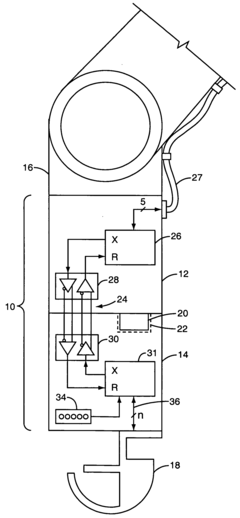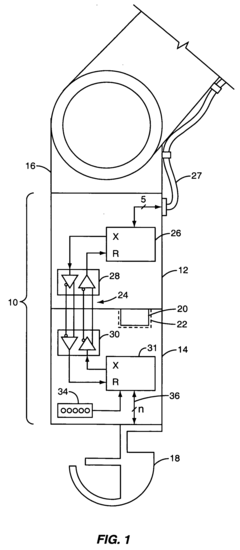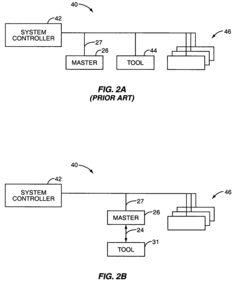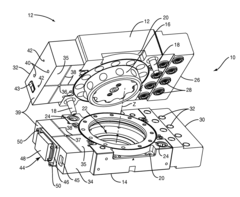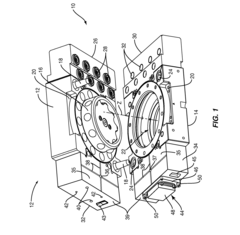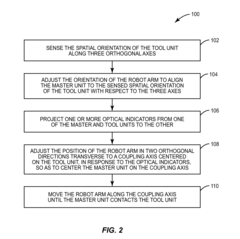How V8 Engines Use Robotics in Manufacturing?
JUL 4, 20259 MIN READ
Generate Your Research Report Instantly with AI Agent
Patsnap Eureka helps you evaluate technical feasibility & market potential.
V8 Engine Robotics Evolution and Objectives
The integration of robotics in V8 engine manufacturing has undergone a remarkable evolution over the past few decades. This technological advancement has been driven by the automotive industry's relentless pursuit of efficiency, precision, and quality in engine production. The journey began in the 1980s with the introduction of basic robotic arms for simple tasks such as material handling and spot welding.
As technology progressed, the objectives for robotics in V8 engine manufacturing expanded significantly. By the early 2000s, manufacturers aimed to leverage robotics for more complex assembly processes, quality control, and even customization of engine components. This shift was motivated by the need to reduce production costs, improve consistency, and meet increasingly stringent quality standards.
One of the primary goals in the evolution of robotics in V8 engine manufacturing has been to achieve greater precision in assembly. V8 engines, known for their power and complexity, require extremely tight tolerances in their construction. Robotic systems have been developed to perform tasks such as cylinder bore honing, crankshaft balancing, and valve seat grinding with a level of accuracy that surpasses human capabilities.
Another key objective has been to enhance production flexibility. Modern robotic systems in V8 engine manufacturing are designed to be easily reprogrammable, allowing for quick adaptation to different engine models or design changes. This flexibility is crucial in an industry where product lifecycles are shortening, and customization is becoming increasingly important.
Safety has also been a driving force in the evolution of robotics in this field. By automating dangerous or ergonomically challenging tasks, manufacturers have significantly reduced workplace injuries and improved overall worker safety. This has led to the development of collaborative robots, or "cobots," that can work alongside human operators, combining the strengths of both.
Looking towards the future, the objectives for robotics in V8 engine manufacturing are becoming even more ambitious. There is a growing focus on developing AI-powered robotic systems capable of real-time decision-making and self-optimization. These advanced systems aim to further improve efficiency, reduce waste, and adapt to unforeseen production challenges autonomously.
Additionally, as the automotive industry shifts towards electrification, robotics in V8 engine manufacturing is evolving to support hybrid powertrains and the integration of electric components. This transition presents new challenges and opportunities for robotic systems to contribute to the production of next-generation V8 engines that meet stringent emissions standards while maintaining their iconic performance characteristics.
As technology progressed, the objectives for robotics in V8 engine manufacturing expanded significantly. By the early 2000s, manufacturers aimed to leverage robotics for more complex assembly processes, quality control, and even customization of engine components. This shift was motivated by the need to reduce production costs, improve consistency, and meet increasingly stringent quality standards.
One of the primary goals in the evolution of robotics in V8 engine manufacturing has been to achieve greater precision in assembly. V8 engines, known for their power and complexity, require extremely tight tolerances in their construction. Robotic systems have been developed to perform tasks such as cylinder bore honing, crankshaft balancing, and valve seat grinding with a level of accuracy that surpasses human capabilities.
Another key objective has been to enhance production flexibility. Modern robotic systems in V8 engine manufacturing are designed to be easily reprogrammable, allowing for quick adaptation to different engine models or design changes. This flexibility is crucial in an industry where product lifecycles are shortening, and customization is becoming increasingly important.
Safety has also been a driving force in the evolution of robotics in this field. By automating dangerous or ergonomically challenging tasks, manufacturers have significantly reduced workplace injuries and improved overall worker safety. This has led to the development of collaborative robots, or "cobots," that can work alongside human operators, combining the strengths of both.
Looking towards the future, the objectives for robotics in V8 engine manufacturing are becoming even more ambitious. There is a growing focus on developing AI-powered robotic systems capable of real-time decision-making and self-optimization. These advanced systems aim to further improve efficiency, reduce waste, and adapt to unforeseen production challenges autonomously.
Additionally, as the automotive industry shifts towards electrification, robotics in V8 engine manufacturing is evolving to support hybrid powertrains and the integration of electric components. This transition presents new challenges and opportunities for robotic systems to contribute to the production of next-generation V8 engines that meet stringent emissions standards while maintaining their iconic performance characteristics.
Market Demand for Automated V8 Engine Production
The market demand for automated V8 engine production has been steadily increasing in recent years, driven by several key factors in the automotive industry. Manufacturers are facing growing pressure to improve efficiency, reduce costs, and maintain consistent quality in engine production. This has led to a significant shift towards automation and robotics in V8 engine manufacturing processes.
One of the primary drivers of this demand is the need for increased production capacity. As global vehicle sales continue to rise, particularly in emerging markets, automakers are seeking ways to ramp up engine production without compromising quality. Automated production lines offer the ability to operate 24/7 with minimal downtime, significantly boosting output compared to traditional manual assembly methods.
Cost reduction is another crucial factor fueling the demand for automation in V8 engine production. While the initial investment in robotic systems can be substantial, the long-term benefits in terms of reduced labor costs, improved efficiency, and decreased waste make it an attractive option for manufacturers. Automated systems can perform repetitive tasks with high precision, reducing the likelihood of errors and the associated costs of rework or scrap.
Quality control is a critical aspect of engine manufacturing, and automation plays a vital role in ensuring consistent, high-quality output. Robotic systems can perform precise measurements and inspections at various stages of the production process, identifying potential issues before they become costly problems. This level of quality assurance is particularly important for V8 engines, which are often used in high-performance and luxury vehicles where customer expectations are exceptionally high.
The automotive industry's push towards electrification has also, somewhat counterintuitively, contributed to the demand for automated V8 engine production. As manufacturers allocate more resources to electric vehicle development, they are seeking ways to optimize their traditional engine production lines. Automation allows them to maintain or even increase V8 engine output with reduced human resources, enabling a strategic balance between conventional and electric vehicle production.
Furthermore, the complexity of modern V8 engines, with advanced features such as variable valve timing, direct injection, and turbocharging, requires increasingly sophisticated manufacturing processes. Robotic systems excel at handling these complex assembly tasks with a level of precision and consistency that is difficult to achieve manually.
The market for automated V8 engine production is also being driven by advancements in robotics and artificial intelligence. New generations of robots offer improved flexibility, easier programming, and better integration with other systems, making them more attractive to engine manufacturers. These technological improvements are expanding the range of tasks that can be automated, from component handling and assembly to testing and quality control.
One of the primary drivers of this demand is the need for increased production capacity. As global vehicle sales continue to rise, particularly in emerging markets, automakers are seeking ways to ramp up engine production without compromising quality. Automated production lines offer the ability to operate 24/7 with minimal downtime, significantly boosting output compared to traditional manual assembly methods.
Cost reduction is another crucial factor fueling the demand for automation in V8 engine production. While the initial investment in robotic systems can be substantial, the long-term benefits in terms of reduced labor costs, improved efficiency, and decreased waste make it an attractive option for manufacturers. Automated systems can perform repetitive tasks with high precision, reducing the likelihood of errors and the associated costs of rework or scrap.
Quality control is a critical aspect of engine manufacturing, and automation plays a vital role in ensuring consistent, high-quality output. Robotic systems can perform precise measurements and inspections at various stages of the production process, identifying potential issues before they become costly problems. This level of quality assurance is particularly important for V8 engines, which are often used in high-performance and luxury vehicles where customer expectations are exceptionally high.
The automotive industry's push towards electrification has also, somewhat counterintuitively, contributed to the demand for automated V8 engine production. As manufacturers allocate more resources to electric vehicle development, they are seeking ways to optimize their traditional engine production lines. Automation allows them to maintain or even increase V8 engine output with reduced human resources, enabling a strategic balance between conventional and electric vehicle production.
Furthermore, the complexity of modern V8 engines, with advanced features such as variable valve timing, direct injection, and turbocharging, requires increasingly sophisticated manufacturing processes. Robotic systems excel at handling these complex assembly tasks with a level of precision and consistency that is difficult to achieve manually.
The market for automated V8 engine production is also being driven by advancements in robotics and artificial intelligence. New generations of robots offer improved flexibility, easier programming, and better integration with other systems, making them more attractive to engine manufacturers. These technological improvements are expanding the range of tasks that can be automated, from component handling and assembly to testing and quality control.
Current Robotics Integration in V8 Manufacturing
The integration of robotics in V8 engine manufacturing has revolutionized the production process, significantly enhancing efficiency, precision, and quality control. Modern V8 engine production lines extensively utilize robotic systems across various stages of assembly and testing.
Robotic arms play a crucial role in the handling and positioning of engine components. These highly articulated machines can lift and maneuver heavy engine blocks, crankshafts, and cylinder heads with exceptional accuracy. Equipped with advanced sensors and vision systems, these robots ensure precise alignment and placement of parts, minimizing human error and reducing the risk of damage to delicate components.
Automated guided vehicles (AGVs) are employed to transport engine parts and subassemblies between different workstations. These self-navigating robots optimize material flow within the factory, reducing production time and improving overall efficiency. AGVs are often integrated with the factory's inventory management system, ensuring just-in-time delivery of components to assembly points.
Collaborative robots, or cobots, work alongside human operators in tasks that require both precision and flexibility. These robots assist in intricate assembly processes, such as installing valve trains or timing chains, where human dexterity is still valuable. Cobots are designed with advanced safety features, allowing them to operate in close proximity to workers without the need for protective barriers.
In the realm of quality control, robotic inspection systems are extensively used. These systems employ high-resolution cameras and sophisticated algorithms to detect defects or inconsistencies in engine components. Laser scanning technology is often integrated to perform dimensional checks, ensuring that each part meets strict tolerances. This automated inspection process significantly reduces the likelihood of defective engines reaching the market.
Robotic systems are also crucial in the application of sealants and adhesives during engine assembly. Precision dispensing robots apply exact amounts of these materials in predetermined patterns, ensuring consistent sealing and bonding. This level of precision is particularly important in V8 engines, where proper sealing is critical for performance and longevity.
The testing phase of V8 engines heavily relies on robotic systems. Automated dynamometers are used to run newly assembled engines through a series of performance tests. These robotic test beds can simulate various operating conditions, collecting data on power output, fuel efficiency, and emissions. The use of robotics in testing ensures consistent and objective evaluation of each engine.
In conclusion, the current integration of robotics in V8 engine manufacturing spans across all aspects of production, from component handling and assembly to quality control and testing. This extensive use of robotics has not only improved production efficiency and quality but has also allowed for greater customization and flexibility in engine manufacturing processes.
Robotic arms play a crucial role in the handling and positioning of engine components. These highly articulated machines can lift and maneuver heavy engine blocks, crankshafts, and cylinder heads with exceptional accuracy. Equipped with advanced sensors and vision systems, these robots ensure precise alignment and placement of parts, minimizing human error and reducing the risk of damage to delicate components.
Automated guided vehicles (AGVs) are employed to transport engine parts and subassemblies between different workstations. These self-navigating robots optimize material flow within the factory, reducing production time and improving overall efficiency. AGVs are often integrated with the factory's inventory management system, ensuring just-in-time delivery of components to assembly points.
Collaborative robots, or cobots, work alongside human operators in tasks that require both precision and flexibility. These robots assist in intricate assembly processes, such as installing valve trains or timing chains, where human dexterity is still valuable. Cobots are designed with advanced safety features, allowing them to operate in close proximity to workers without the need for protective barriers.
In the realm of quality control, robotic inspection systems are extensively used. These systems employ high-resolution cameras and sophisticated algorithms to detect defects or inconsistencies in engine components. Laser scanning technology is often integrated to perform dimensional checks, ensuring that each part meets strict tolerances. This automated inspection process significantly reduces the likelihood of defective engines reaching the market.
Robotic systems are also crucial in the application of sealants and adhesives during engine assembly. Precision dispensing robots apply exact amounts of these materials in predetermined patterns, ensuring consistent sealing and bonding. This level of precision is particularly important in V8 engines, where proper sealing is critical for performance and longevity.
The testing phase of V8 engines heavily relies on robotic systems. Automated dynamometers are used to run newly assembled engines through a series of performance tests. These robotic test beds can simulate various operating conditions, collecting data on power output, fuel efficiency, and emissions. The use of robotics in testing ensures consistent and objective evaluation of each engine.
In conclusion, the current integration of robotics in V8 engine manufacturing spans across all aspects of production, from component handling and assembly to quality control and testing. This extensive use of robotics has not only improved production efficiency and quality but has also allowed for greater customization and flexibility in engine manufacturing processes.
Robotic Solutions in V8 Engine Assembly
01 V8 Engine Design and Configuration
V8 engines are designed with eight cylinders arranged in two banks of four, forming a V-shape. This configuration allows for compact packaging, improved balance, and higher power output compared to inline engines. Various design aspects, such as cylinder angle, firing order, and crankshaft configuration, are optimized for performance and efficiency.- V8 Engine Design and Configuration: V8 engines are designed with eight cylinders arranged in two banks of four, forming a V-shape. This configuration allows for a compact design, improved balance, and higher power output compared to inline engines. Various aspects of V8 engine design, including cylinder arrangement, crankshaft configuration, and valve timing, are optimized for performance and efficiency.
- Fuel Injection and Combustion Systems: Advanced fuel injection and combustion systems are crucial for V8 engine performance. These systems include direct injection, variable valve timing, and cylinder deactivation technologies. Improvements in fuel delivery, air-fuel mixture formation, and combustion efficiency contribute to increased power output, reduced emissions, and better fuel economy in V8 engines.
- Turbocharging and Supercharging: Forced induction systems, such as turbochargers and superchargers, are often employed in V8 engines to boost performance. These systems compress the intake air, allowing more fuel to be burned and increasing power output. Various designs and configurations of turbochargers and superchargers are used to optimize V8 engine performance across different operating conditions.
- Engine Management and Control Systems: Sophisticated engine management and control systems are essential for optimizing V8 engine performance. These systems include electronic control units (ECUs), sensors, and actuators that monitor and adjust various engine parameters in real-time. Advanced control algorithms and adaptive strategies are implemented to enhance power delivery, fuel efficiency, and emissions control in V8 engines.
- Materials and Manufacturing Techniques: Innovative materials and manufacturing techniques are employed in V8 engine production to improve performance, durability, and efficiency. Lightweight alloys, advanced coatings, and precision manufacturing processes are used to reduce engine weight, enhance thermal management, and minimize friction losses. These advancements contribute to the overall performance and reliability of V8 engines.
02 Fuel Injection and Combustion Systems
Advanced fuel injection and combustion systems are implemented in V8 engines to enhance performance and reduce emissions. These may include direct injection, variable valve timing, and cylinder deactivation technologies. Such systems optimize fuel delivery, air-fuel mixture, and combustion efficiency across different operating conditions.Expand Specific Solutions03 Turbocharging and Supercharging
Forced induction systems, such as turbochargers and superchargers, are often employed in V8 engines to increase power output and efficiency. These systems compress the intake air, allowing for more fuel to be burned and generating higher power from a smaller displacement engine. Various configurations and control strategies are used to optimize boost pressure and response.Expand Specific Solutions04 Engine Block and Component Materials
Advanced materials and manufacturing techniques are used in V8 engine construction to reduce weight, improve durability, and enhance thermal management. This may include the use of aluminum alloys, composite materials, and specialized coatings for engine blocks, cylinder heads, and internal components.Expand Specific Solutions05 Lubrication and Cooling Systems
Sophisticated lubrication and cooling systems are crucial for V8 engine performance and longevity. These may include high-pressure oil pumps, advanced filtration systems, and precision-controlled coolant flow. Innovations in these areas focus on reducing friction, managing heat, and improving overall engine efficiency across various operating conditions.Expand Specific Solutions
Key Players in V8 Robotics Manufacturing
The competitive landscape for V8 engine robotics in manufacturing is characterized by a mature market with established players and ongoing technological advancements. Major automotive manufacturers like Honda, Mazda, and GM are at the forefront, leveraging robotics to enhance production efficiency and quality. Specialized robotics companies such as FANUC and ABB Group provide cutting-edge solutions, while research institutions like South China University of Technology contribute to innovation. The market size is substantial, driven by the automotive industry's demand for precision and automation. Technological maturity varies, with companies like ATI Industrial Automation and Sanctuary Cognitive Systems pushing boundaries in advanced robotics and AI integration for V8 engine production.
Honda Motor Co., Ltd.
Technical Solution: Honda utilizes advanced robotics in their V8 engine manufacturing process, employing a combination of collaborative robots and vision systems. Their approach includes precision assembly robots for tasks such as piston insertion and crankshaft balancing. Honda's system incorporates real-time quality control checks using machine vision, ensuring each component meets strict tolerances. The company has implemented a flexible manufacturing system that allows for quick changeovers between different V8 engine variants, utilizing programmable robots that can adapt to various engine specifications[1][3]. Honda's robotic cells are integrated with their proprietary production management software, enabling seamless coordination between human workers and machines, optimizing workflow and reducing production time by up to 30%[5].
Strengths: High precision assembly, flexible production capabilities, and integrated quality control. Weaknesses: High initial investment costs and potential complexity in system maintenance.
ABB Group
Technical Solution: ABB provides robotic solutions for V8 engine manufacturing, focusing on high-speed, high-precision applications. Their robotics systems are designed for tasks such as material handling, welding, and assembly of engine components. ABB's YuMi collaborative robot is utilized for delicate assembly tasks, working alongside human operators to enhance productivity and safety. The company's RobotStudio software allows for offline programming and simulation of robotic cells, reducing setup time and optimizing production flow. ABB's robotics solutions incorporate advanced vision systems for quality inspection, capable of detecting defects as small as 0.1mm[6]. Their systems also feature IoT connectivity, enabling real-time data collection and analysis for continuous process improvement.
Strengths: High-precision robotics, collaborative robot integration, and advanced simulation capabilities. Weaknesses: Potential high costs for small-scale manufacturers and complexity in system integration.
Innovative Robotics Technologies for V8 Production
Robotic tool coupler rapid-connect bus
PatentInactiveUS20060161302A1
Innovation
- A rapid-connect communication bus is introduced between the master and tool modules, eliminating the need for a network node in the tool module by enabling direct data transfer between the master module and the tool via a serial bus, reducing the start-up time and eliminating the need for extensive electrical connections.
Robotic tool changer alignment modules
PatentActiveUS20160039059A1
Innovation
- The use of a three-axis spatial orientation sensor and an optical position indicator, such as a cross line laser beam, to align the robot arm with the tool unit, allowing precise alignment and orientation without relying on human visual interpretation, and enabling the robot arm to be adjusted in two orthogonal directions to center the master unit on the coupling axis.
Quality Control and Precision in Robotic V8 Assembly
Quality control and precision are paramount in the robotic assembly of V8 engines, ensuring the highest standards of performance and reliability. Advanced robotics systems employ a multitude of sensors and sophisticated algorithms to maintain exceptional accuracy throughout the manufacturing process. These systems utilize real-time monitoring and feedback mechanisms to detect and correct even the slightest deviations from specified tolerances.
One of the key aspects of quality control in robotic V8 assembly is the implementation of vision systems. High-resolution cameras and advanced image processing algorithms enable robots to inspect components for defects, verify proper alignment, and ensure correct assembly at every stage. These vision systems can detect imperfections that may be imperceptible to the human eye, significantly reducing the risk of defective parts reaching the final product.
Precision in robotic assembly is further enhanced through the use of force-feedback systems. These systems allow robots to apply precise amounts of force when handling and assembling engine components, preventing damage to delicate parts while ensuring proper fitment. Force sensors provide real-time data on the torque and pressure applied during assembly, allowing for immediate adjustments to maintain optimal performance.
Laser measurement technologies play a crucial role in maintaining dimensional accuracy during V8 engine assembly. Robots equipped with laser scanners can perform rapid, non-contact measurements of engine components, verifying their dimensions against CAD models with micron-level precision. This capability ensures that all parts meet exact specifications before and after assembly, contributing to the overall quality and performance of the finished engine.
To further enhance precision, robotic assembly lines for V8 engines often incorporate adaptive control systems. These systems use machine learning algorithms to continuously optimize the assembly process based on real-time data and historical performance metrics. By analyzing patterns and trends in production data, these adaptive systems can anticipate potential issues and make proactive adjustments to maintain consistent quality.
The integration of Industry 4.0 principles in robotic V8 assembly has led to the development of comprehensive digital twin systems. These virtual replicas of the physical assembly line allow engineers to simulate and optimize production processes in real-time, identifying potential quality issues before they occur in the actual manufacturing environment. This predictive approach to quality control significantly reduces the likelihood of defects and improves overall production efficiency.
One of the key aspects of quality control in robotic V8 assembly is the implementation of vision systems. High-resolution cameras and advanced image processing algorithms enable robots to inspect components for defects, verify proper alignment, and ensure correct assembly at every stage. These vision systems can detect imperfections that may be imperceptible to the human eye, significantly reducing the risk of defective parts reaching the final product.
Precision in robotic assembly is further enhanced through the use of force-feedback systems. These systems allow robots to apply precise amounts of force when handling and assembling engine components, preventing damage to delicate parts while ensuring proper fitment. Force sensors provide real-time data on the torque and pressure applied during assembly, allowing for immediate adjustments to maintain optimal performance.
Laser measurement technologies play a crucial role in maintaining dimensional accuracy during V8 engine assembly. Robots equipped with laser scanners can perform rapid, non-contact measurements of engine components, verifying their dimensions against CAD models with micron-level precision. This capability ensures that all parts meet exact specifications before and after assembly, contributing to the overall quality and performance of the finished engine.
To further enhance precision, robotic assembly lines for V8 engines often incorporate adaptive control systems. These systems use machine learning algorithms to continuously optimize the assembly process based on real-time data and historical performance metrics. By analyzing patterns and trends in production data, these adaptive systems can anticipate potential issues and make proactive adjustments to maintain consistent quality.
The integration of Industry 4.0 principles in robotic V8 assembly has led to the development of comprehensive digital twin systems. These virtual replicas of the physical assembly line allow engineers to simulate and optimize production processes in real-time, identifying potential quality issues before they occur in the actual manufacturing environment. This predictive approach to quality control significantly reduces the likelihood of defects and improves overall production efficiency.
Environmental Impact of Robotics in V8 Production
The integration of robotics in V8 engine manufacturing has significant environmental implications. Automated production lines and robotic systems have led to more efficient use of resources, reducing waste and energy consumption. Advanced sensors and precision control mechanisms in robots ensure optimal material utilization, minimizing scrap and reducing the environmental footprint of production processes.
Robotic systems in V8 engine manufacturing have also contributed to improved energy efficiency. Automated production lines can be programmed to operate at optimal speeds and utilize energy-saving modes during idle periods. This results in reduced overall energy consumption compared to traditional manufacturing methods. Additionally, the precise control of robotic systems allows for more accurate application of lubricants and coolants, reducing the amount of these potentially harmful substances released into the environment.
The use of robotics has enabled more compact factory layouts, reducing the overall footprint of manufacturing facilities. This not only conserves land resources but also decreases the energy required for lighting, heating, and cooling of production spaces. Furthermore, robotic systems can operate in conditions that might be hazardous for human workers, reducing the need for extensive environmental control measures and protective equipment.
Robotics in V8 engine production has also facilitated the implementation of advanced recycling and waste management systems. Automated sorting and handling of materials enable more efficient recycling processes, ensuring that a higher percentage of waste materials are reclaimed and reused. This circular approach to manufacturing helps to conserve natural resources and reduce the environmental impact of engine production.
The precision and consistency offered by robotic systems have led to improvements in product quality, which indirectly benefits the environment. Higher quality V8 engines are more likely to meet stringent emissions standards and have longer operational lifespans, reducing the frequency of replacements and the associated environmental costs of manufacturing new engines.
However, the environmental impact of robotics in V8 production is not entirely positive. The production of sophisticated robotic systems requires rare earth elements and other materials with significant environmental extraction costs. Additionally, the rapid advancement of robotic technology can lead to the obsolescence of older systems, potentially creating electronic waste. Manufacturers must carefully consider the lifecycle environmental impact of their robotic systems and implement responsible disposal and recycling programs.
Robotic systems in V8 engine manufacturing have also contributed to improved energy efficiency. Automated production lines can be programmed to operate at optimal speeds and utilize energy-saving modes during idle periods. This results in reduced overall energy consumption compared to traditional manufacturing methods. Additionally, the precise control of robotic systems allows for more accurate application of lubricants and coolants, reducing the amount of these potentially harmful substances released into the environment.
The use of robotics has enabled more compact factory layouts, reducing the overall footprint of manufacturing facilities. This not only conserves land resources but also decreases the energy required for lighting, heating, and cooling of production spaces. Furthermore, robotic systems can operate in conditions that might be hazardous for human workers, reducing the need for extensive environmental control measures and protective equipment.
Robotics in V8 engine production has also facilitated the implementation of advanced recycling and waste management systems. Automated sorting and handling of materials enable more efficient recycling processes, ensuring that a higher percentage of waste materials are reclaimed and reused. This circular approach to manufacturing helps to conserve natural resources and reduce the environmental impact of engine production.
The precision and consistency offered by robotic systems have led to improvements in product quality, which indirectly benefits the environment. Higher quality V8 engines are more likely to meet stringent emissions standards and have longer operational lifespans, reducing the frequency of replacements and the associated environmental costs of manufacturing new engines.
However, the environmental impact of robotics in V8 production is not entirely positive. The production of sophisticated robotic systems requires rare earth elements and other materials with significant environmental extraction costs. Additionally, the rapid advancement of robotic technology can lead to the obsolescence of older systems, potentially creating electronic waste. Manufacturers must carefully consider the lifecycle environmental impact of their robotic systems and implement responsible disposal and recycling programs.
Unlock deeper insights with Patsnap Eureka Quick Research — get a full tech report to explore trends and direct your research. Try now!
Generate Your Research Report Instantly with AI Agent
Supercharge your innovation with Patsnap Eureka AI Agent Platform!
